i bc27f85be50b71b1 (79 page)
Read i bc27f85be50b71b1 Online
Authors: Unknown

NO: Ability to construct shapes, awareness
NO: Constructional apraxia, geographic
of external environmenr, and body image
agnosia, dressing apraxia, anosognosia
Wernicke's area
0: Sensory speech (auditory and written)
Wernicke's ( receptive) aphasia
comprehension center
NO: Appreciation of content of emmional
language (e.g., tone of voice)
Optic radiation
Visual tract
Lower homonymous quadrantanopia
GustatOry cortex
Perception of taste
Dysfunction is very uncommon
Temporal
Superior
0: Appreciation of language
0: Decreased ability to hear
lobe
temporal gyrus
NO: Appreciation of music, rhythm,
NO: Decreased ability to appreciate music
(audicory
and sound
cortex)
Middle and
Learning and memory ceorers
Learning and memory deficits
inferior
tern pora I gyri
Limbic lobe and
Affective and emotion center, including
Aggressive or antisocial behaviors
olfaccory
mood, primitive behavior, self
Inability to establish new memories
cortex
preservation, shorr-term memory,
visceral emotion processes, and
interpretation of smell
z
i::
Wernicke's area
See Parietal lobe, above
Wernicke's ( receptive) aphasia
<
�
� ..... '" w


Tab1c 4-1. Continued
N
'"
....
Lobe of
Structure
Function
Dysfunction
>
Cerebrum
� �
Optic radiation
Visual tract
Upper homonymous Quadranranopia
"
'"
Occipital
Striate and
Perception of vision (visual cortex)
Homonymous hemianopsia with or with
J:
>
lobe
parastriare
out macular involvement
Z
"
cortices
�
o
"
o = dominant, ND = nondol11inant.
o
Sources: Data from KW Lindsay, I Bone, R Callander (eds). Neurology and Ncurosurgery Illustrated (2nd cd). Edinburgh, UK: Church.1l
"
Livingscone. 1991; S Gilman. SW Newman (cds). Manrer and Gaez's Esscmials of Clmical Neuroanatomy and Neurophysiology (7th ed).
=t
Philadelphia: FA Davis, 1989;JA Kiernan (ed). lntroduCtion CO Human Neuroscience. Philadelphia: Lippincott, 1987; EN Marieb (cd). Human
�
Anatomy and Physiology (5th ed). San Francisco: Benjamin-Cummings, 200t; and L Thelan, J Davic, M Lough (eds). Cnncal Care Nursing: i'i
>
Diagnosis and Managemcll( (2nd cd). Sr. Louis: Mosby, 1994.
r
i
'"
!:'
�


Table 4-2. Structure, Function, and Dysfunction of the Diencephalon, Brain Stem, and Cerebellum
Brain Structure
Substructure
Function
Dysfunction
Diencephalon
Thalamus
Specific and association nuclei
Cortical arousal
Altered consciousness
Integrative relay station for all
Signs and symptoms of increased
ascending and descending
ICP
motor stimuli and aU ascending
Contralateral hemiplegia,
sensory stimuli except smell
hemiparesis, or hemianesthesia
Memory
Altered eye movement
Hypothalamus
Mamillary bodies
Autonomic center for sympa
Altered autonomic function and
Optic chiasm
thetic and parasympathetic
vital signs
Infundibulum (stalk) connects
responses
Headache
to the pituitary gland
Visceral center for regulation of
Visual deficits
Forms inferolateral wall of third
body temperature, food
Vomiting with signs and
ventricle
intake. thirst, sleep and wake
symptoms of increased ICP
cycle, water balance
See Chapter 11 for more
Produces ADH and oxytocin
information on hormones and
Regulates anterior pituirary
endocrine disorders
gland
�
Association with limbic system
13
5<
� N '" '"


Table 4-2. Continued
N
'"
'"
Brain Structure
Substructure
Function
Dysfunction
>
n
Epithalamus
Pineal body
Association with limbic system
Dysfunction unknown
�
Posterior commissure. striae
n
>
medulla res, habenular nuclei
'"
'"
and commissure
J:
>
Subthalamus
Substantia nigra
Z
Association with thalamus for
Dyskinesia and decreased motor
"
�
Red nuclei
motor control
control
0
0
Pituitary
Anterior and posterior lobes
Production, storage, and
See Chapter 1 1 for more
'"
�
secretion of reproductive
information on hormones and
0
'"
hormones
endocrine disorders
�
J:
Secretion of ADH and oxytocin
-<
�
Internal capsule
Fiber tracts connecting
Conduction pathway berween
Contralateral hemiparesis or
1)
>
thalamus to the cortex
the cortex and spinal cord
hemiplegia and hemianesthesia
r
JI
Brain stem
'"
'"
Midbrain
Superior cerebellar peduncles
Conduction pathway berween
Contralateral hemiparesis or
>
�
Superior and inferior colliculi
higher and lower brain centers
hemiplegia and hemianesthesia,
�
Medial and lateral lemniscus
Visual reflex
altered consciousness and
eNs IIJ and IV nuclei
Auditory reflex
respiratory pattern, cranial
Reticular formation
nerve palsy
Cerebral aqueduct in its center

Pons
Middle cerebellar peduncles
Conduction pathway between
See Midbrain. above
Respiratory center
higher and lower brain
CNs V-VUI nuclei
centers
Forms anterior wall of fourth
ventricle
Medulla
Decussation of pyramidal tracts
Homeostatic center for cardiac,
See Midbrain, above
Inferior cerebellar peduncles
respiramry, vasomotor
Inferior olivary nuclei
functions
Nucleus cuneatus and gracilis
CNs [x-Xil nuclei
:erebellum
Anterior lobe
Medial portion
